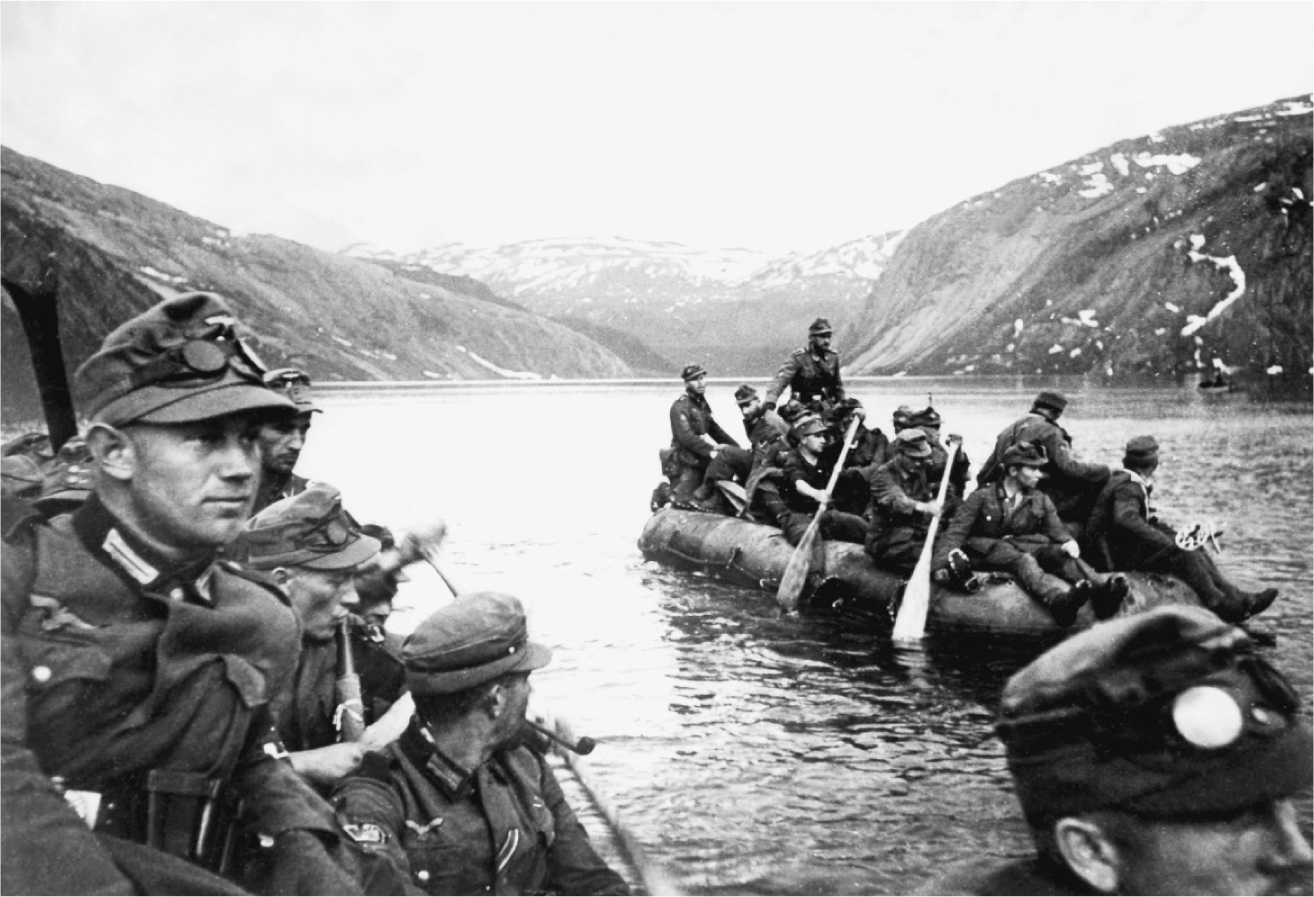
German troops cross a fjord, Norway, 1940.

German troops cross a fjord, Norway, 1940.
THE QUESTION OF when the fighting would begin, and how, remained unanswered. Frequent false alarms of a German attack on Belgium or Holland kept the Allies on their toes, but never amounted to anything. As winter gave way to spring, attention moved instead from the Low Countries to Scandinavia, of all unlikely places.
The background to this was the Soviet attack on Finland that began in November of 1939, intended by Stalin to secure a broad swath of territory to the north of Leningrad and reduce Finland, which had declared its independence from Russia in 1918, to a vassal state. The war was a costly and humiliating disaster for the Soviet Union. Although outnumbered three to one by the Russians, and even more so in terms of arms—the Finnish Army had twenty-four tanks while the Red Army deployed several thousand—the Finns resisted heroically and effectively, helped by the arctic winter conditions, the paucity of roads, and the inefficiency of the Red Army, the senior officers of which had been decimated in Stalin’s great purge of their ranks in 1937.
The temptation to come to Finland’s aid was felt strongly in London and Paris, but apart from small quantities of supplies and arms it was difficult to find any way to reach Finland. Continuing and heroic resistance there, however, focused attention on Scandinavia, particularly that of the first lord of the Admiralty.
Winston Churchill had been drawing the War Cabinet’s attention for some time to the fact that nearly half of Germany’s iron ore came from the mines at Luleå, in Sweden, much of it transported by railway to the Norwegian port of Narvik and thence by sea to Germany down the coast of Norway behind the long chain of islands and fjords known as the Leads, so that the freighters were always in neutral Norwegian territorial waters. Churchill described this as a “sheltered” or “covered” way, within the Norwegian three-mile limit. This, surely, was a naval matter, he argued. Seizing Narvik would enable the Allies to support the Finns against the Russians, and at the same time cut off shipments of iron ore to Germany.
The fact that Norway and Sweden were both neutral countries and terrified of German reprisal did not slow down speculation on this project in London and Paris. Surprisingly, the French were intrigued enough to offer troops for the operation—the Chasseurs Alpins (French mountain troops), the Foreign Legion, Polish forces—for the French government was moved by two contradictory impulses, the first being the fear that if it continued to do nothing it would be thrown out of office, and the second that if the war was going to be fought at all, the farther away the fighting was from France, the better—if it was a naval or amphibious war in which the British predominated, better still.
Serious preparations were made in strictest (but unavailing) secrecy for winter warfare in Finland. Hurricanes were experimentally fitted with skis so that they could operate from snowy airfields, officers who could claim skiing experience from glamorous winter holidays in Davos or St. Moritz were withdrawn from their regiments and sent to northern Scotland to train troops in “winter warfare,” all of it captured brilliantly by Evelyn Waugh in Put Out More Flags when Peter Pastmaster turns up at the bar in “Bratt’s” (Waugh’s pseudonym for White’s) in the battledress of a different regiment than his own:
“Hullo. Why on earth are you dressed like that?”
Peter smirked as only a soldier can when he knows a secret. “Oh, no particular reason.” . . .
“You’re the sixth chap I’ve seen in disguise this morning.”
“That’s the idea—security, you know.” . . .
They went to the bar.
“Good morning, my lord,” said MacDougal, the barman. “I see you’re off to Finland too. Quite a number of our gentlemen are going to-night.”
In the end nobody did go to Finland. David forced Goliath to a costly stalemate (the Finns lost 25,000 men, the Soviet Union nearly 150,000), Finland accepted terms less generous than it might have had from Stalin without fighting, but received admiration from neutrals and from both belligerent sides for exposing the greed, incompetence, and cynicism of the Soviet Union.
In the meantime, the idea of seizing the remote and unprepossessing port of Narvik remained in Churchill’s mind, another bee in that capacious bonnet, and he sent the prime minister a series of long papers describing the benefits that would follow from it. One might have thought that memory of the failure of Churchill’s cherished plan to breach the Dardanelles with warships in 1915 and drive Turkey out of the war would have set off alarm bells in the minds of other members of the War Cabinet, but apparently it did not. Once again a combined naval and military expedition with enormous risks was being proposed, the previous one having cost Churchill his career for a time, as well as the lives of nearly a quarter of a million men for no gain, but possibly Churchill’s energy and powers of persuasion were too strong to resist. More likely it was simply that he was the only member of the War Cabinet who wanted a fight, a hawk in the dovecote.
Churchill had already begun pressing his case as early as September 19, 1939, only sixteen days after the beginning of the war, but the War Cabinet’s initial interest soon gave way to caution at the prospect of infringing the neutrality of two countries. Churchill reluctantly reduced his plan to “mining the Leads” to prevent ore traffic to Germany, but this too dragged on, in the absence of Norwegian permission to allow it.
Unfortunately, Churchill was not the only person whose eye was set on Norway. As early as October 3, 1939, the Führer had taken the first steps toward what would become code-named Unternehmen Weserübung, the invasion of Denmark and Norway. By December 14 he had made up his mind, and by February 20, 1940, he had appointed a commander, General von Falkenhorst, who had fought in Finland briefly in 1918 and therefore had some experience of the Scandinavian terrain. This was in sharp contrast to Britain, where War Cabinet discussion of what was tentatively called Operation Wilfred dragged on for months and ended with a mishmash of a plan, in which the main part of the operation was naval, in addition to which “a British brigade and a French contingent” might be landed by the navy to seize Narvik, then advance to the Swedish frontier.
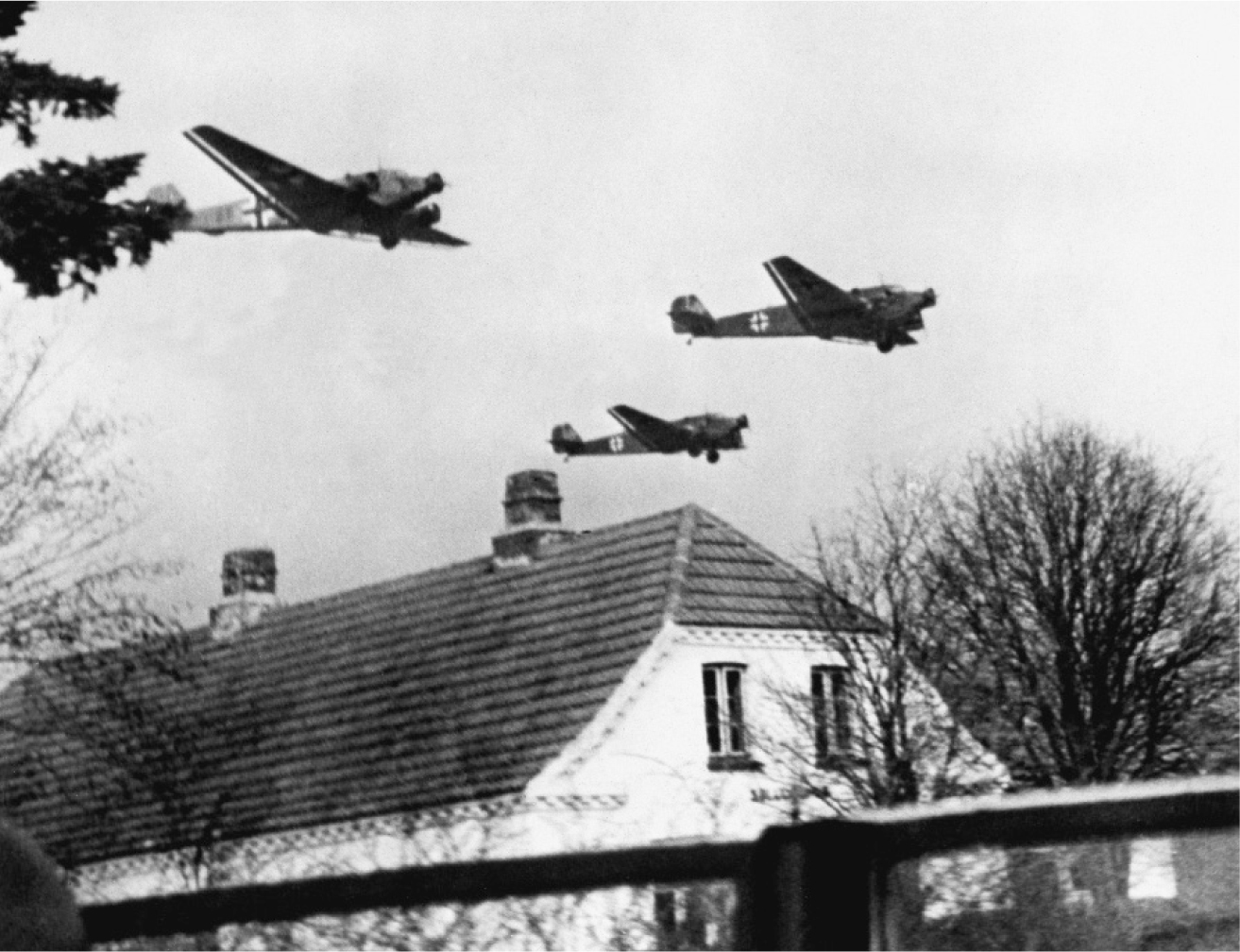
German Ju 52 transport aircraft over Copenhagen, 1940.
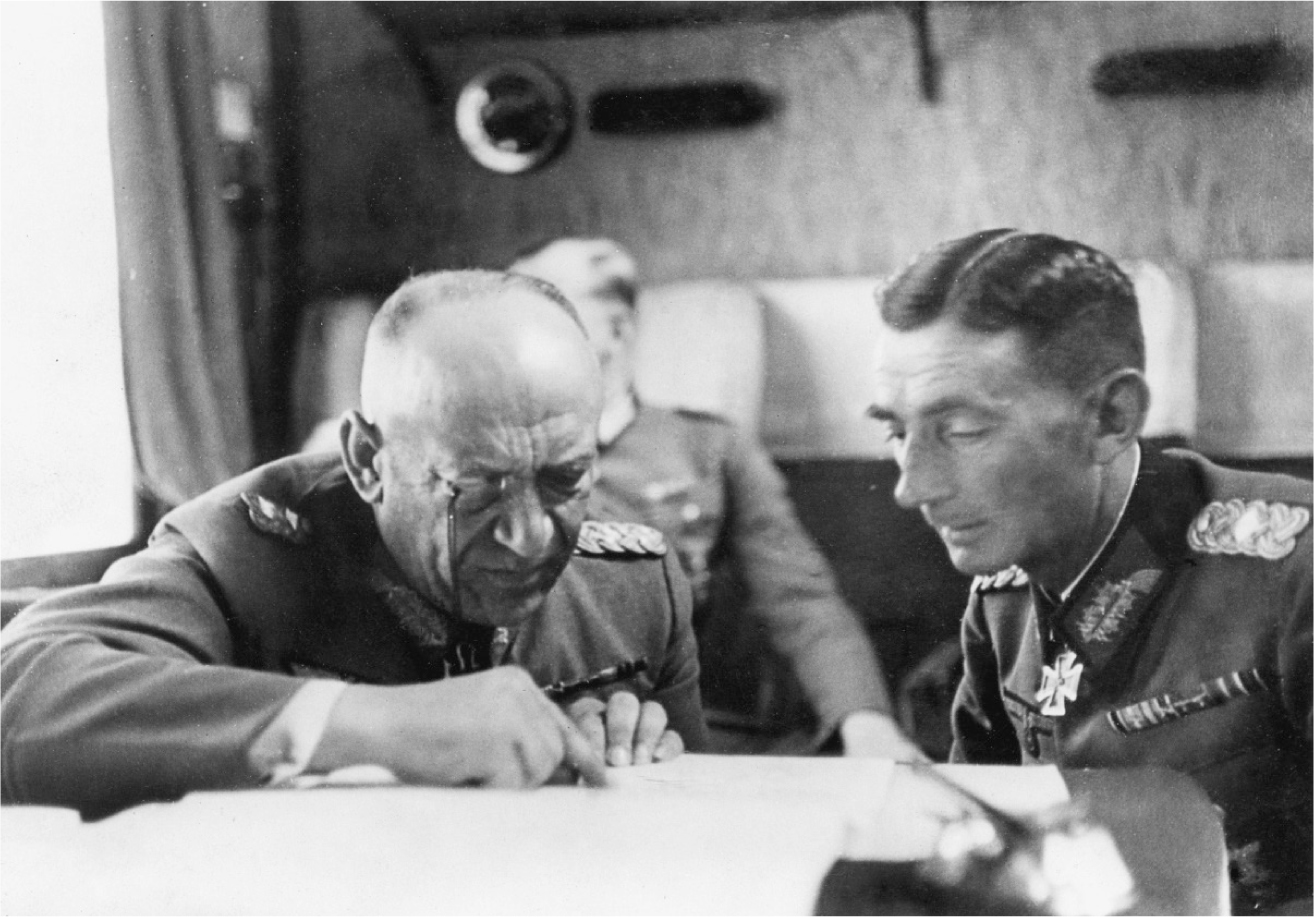
General von Falkenhorst (left), commander of the invasion of Norway.
The opinion of professional soldiers was tartly expressed by Lieutenant-General Pownall in his diary: “I understand that it is the plan of those master strategists Winston and Ironside. . . . Of all the harebrained projects I have heard this is the most foolish—its inception smacks too alarmingly of Gallipoli.* . . . Sideshows again—Winston Churchill is no longer held in check by a C.I.G.S. of the type of Robertson [Field Marshal Sir William Robertson, CIGS from 1916 to 1918] but encouraged in his broad sweeping ideas by an Ironside whose basic military knowledge is nil and has never studied strategy in its broad sense… .” Pownall was concerned that any operation in Scandinavia would inevitably draw troop strength away from the BEF in France at just the moment when the Germans could be expected to attack.
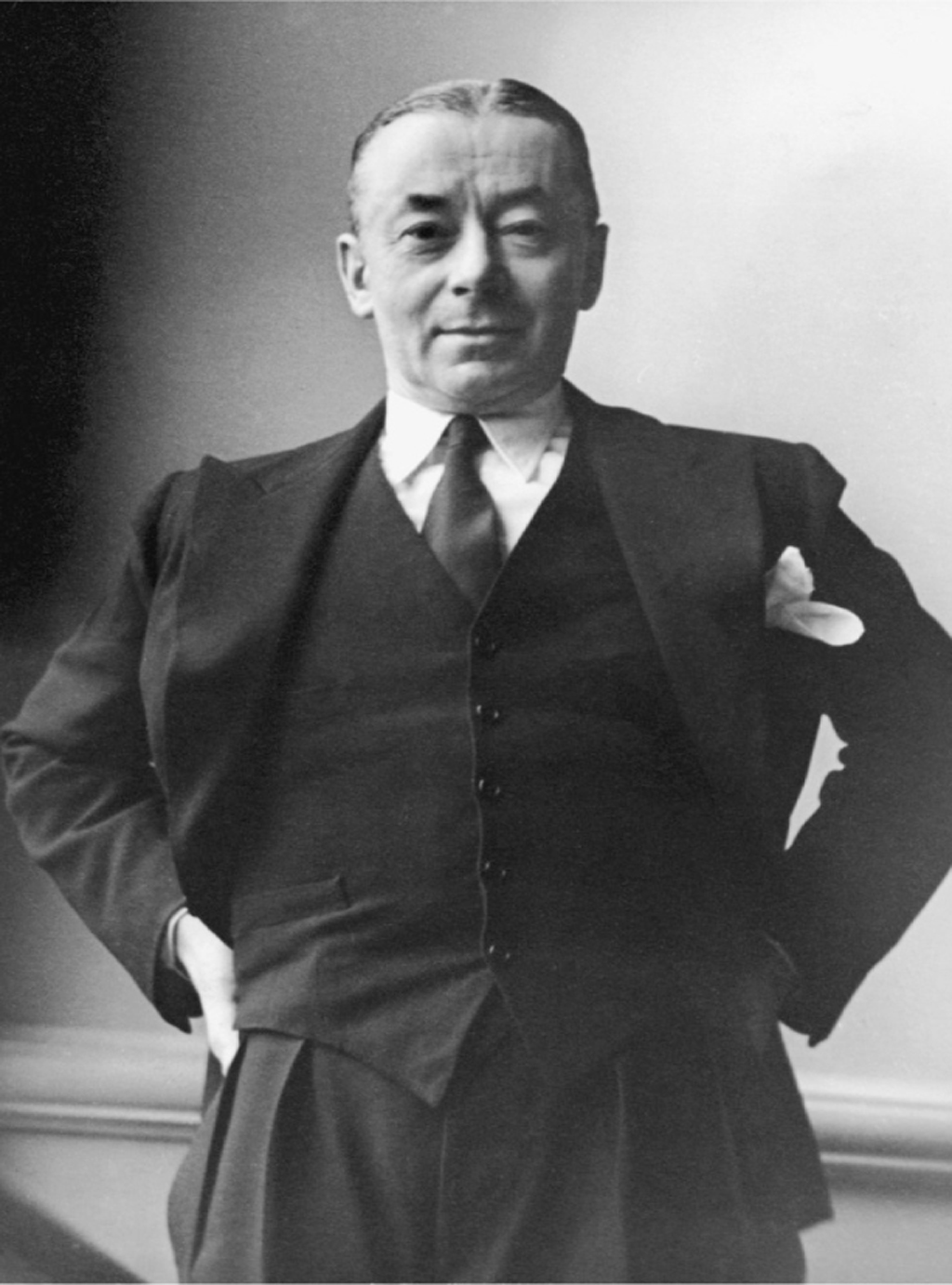
Paul Reynaud.
A change in the premiership in France—the cautious M. Daladier was replaced by the slightly less cautious M. Paul Reynaud, the latter having been against the Munich settlement, the former a shame-faced but unrepentant participant in the dismemberment of Czechoslovakia—led the Supreme War Council to agree to launch Operation Wilfred on April 9, although the military side of the plan still called for that traditional harbinger of disaster, the landing of what General Montgomery would refer to disparagingly later in the war as “penny packets” of troops at widely separated places on the Norwegian coast, without a commander in chief or a plan for a single decisive blow. As has so often been the case in English history, the fact that the Royal Navy was involved on a large scale led members of the War Cabinet to overlook the obvious risks on the ground—the age-old British trust in anything that depends on the navy.
Confidence in the operation was high, so much so that the prime minister, jauntily assured his audience in a speech to the Central Council of the National Union of Conservatives and Unionist Associations on April 5, “one thing is certain, [Hitler] missed the bus.”
Winston Churchill, many years later, would write with commendable restraint, “This proved an ill-judged utterance,” and truer words were never written. At about the same time as Chamberlain was speaking, the German Navy was landing troops at Bergen, Trondheim, and Narvik in neutral Norway.† Neutral Denmark as well was invaded and the king of Denmark surrounded in his own palace. The Germans seized the major ports and cities while the British struggled to hold the rugged, snow swept, underpopulated terrain of northern Norway. “Within forty-eight hours all the main ports of Norway were in the German grip,” Churchill wrote. “Surprise, ruthlessness and precision were the characteristics of the onslaught upon innocent and naked Norway.”
The Allied response was muddled. Clearly, as Churchill admitted, Britain and France had been “forestalled, surprised . . . and outwitted,” but at sea the Royal Navy prevailed, although Hitler did not have the same interest in his navy that he had in his army, so naval matters were never his first concern. A photograph of Hitler in a naval cutter inspecting the fleet before the war shows the Führer with wind-tousled hair and the uneasy expression of a landlubber fighting seasickness. When the navy suggested naming its new 50,000-ton super-battleship after him, Hitler declined on the grounds that it would damage German morale if a ship named after him were sunk, so it was named Bismarck instead. (Hitler’s premonition was sound: the Bismarck was sunk on May 27, 1941, after a long chase during which she sank the pride of the British fleet, the battlecruiser HMS Hood.)
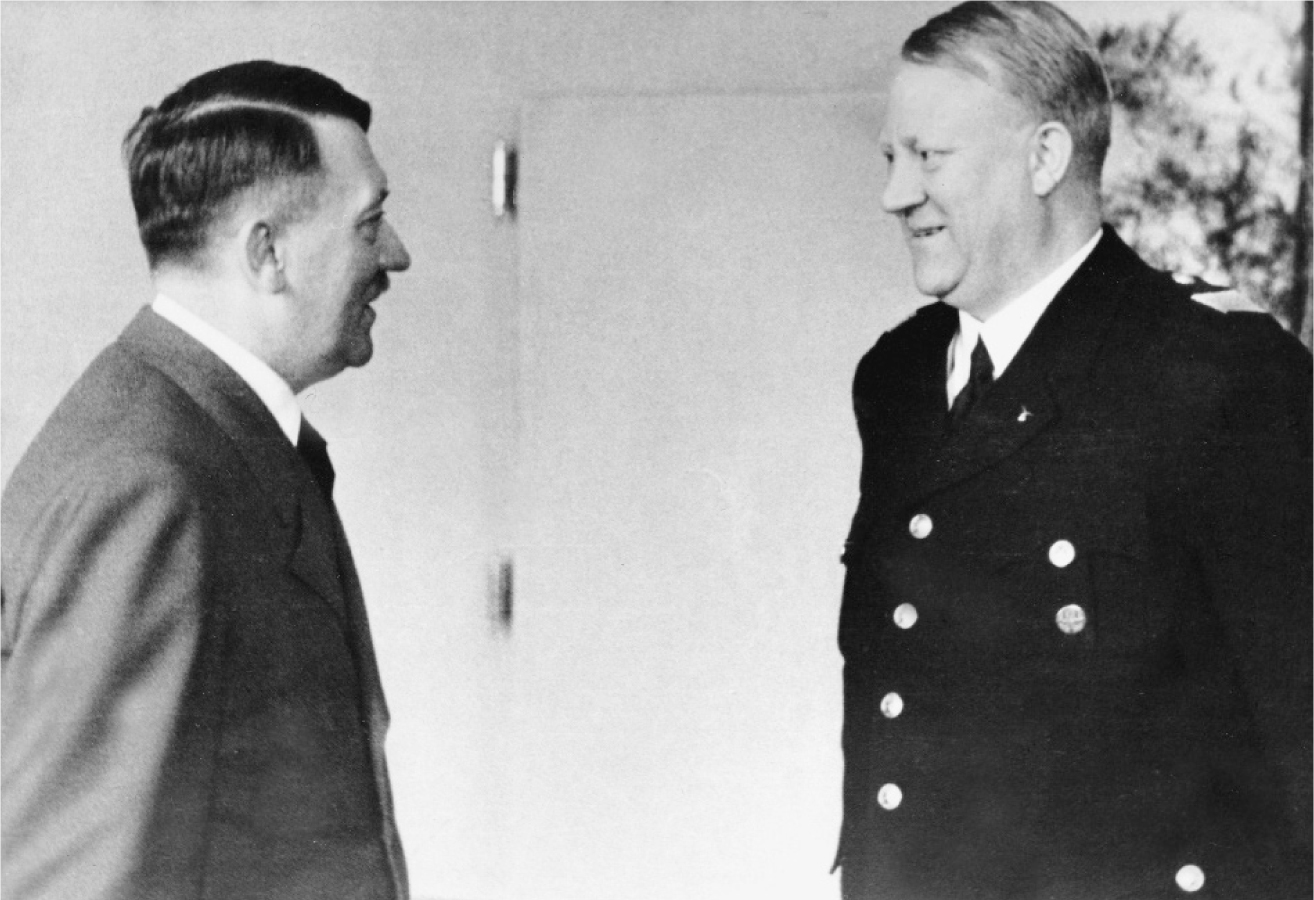
Hitler with Vidkun Quisling.
The Norwegian campaign cost the German Navy three cruisers and ten destroyers, and together with those warships that had been heavily damaged Hitler’s navy would be in no position to carry out an invasion of England in the summer of 1940. On the land, however, the German Army gained yet another quick victory. By the first week of June all of Norway was in German hands, the king and his family were on the way to Britain in a British cruiser, and a pro-German government had been set up under Major Vidkun Quisling, a Fascist politician whose name would be used to describe every collaborationist leader ever since.
_________________________
* The focal point of the disastrous Allied attack to force the Dardanelles and take Constantinople in 1915, of which Churchill was the most outspoken supporter.
† Neutrality is not a sacred cause or a permanent state, except perhaps to the Swiss; it merely describes a country that by diplomatic skill or fortunate geography, or both, is able to stay out of the war and hopes to do business with both sides. In World War Two this included Switzerland, Sweden, Spain, Portugal, and, until December 7, 1941, the United States.